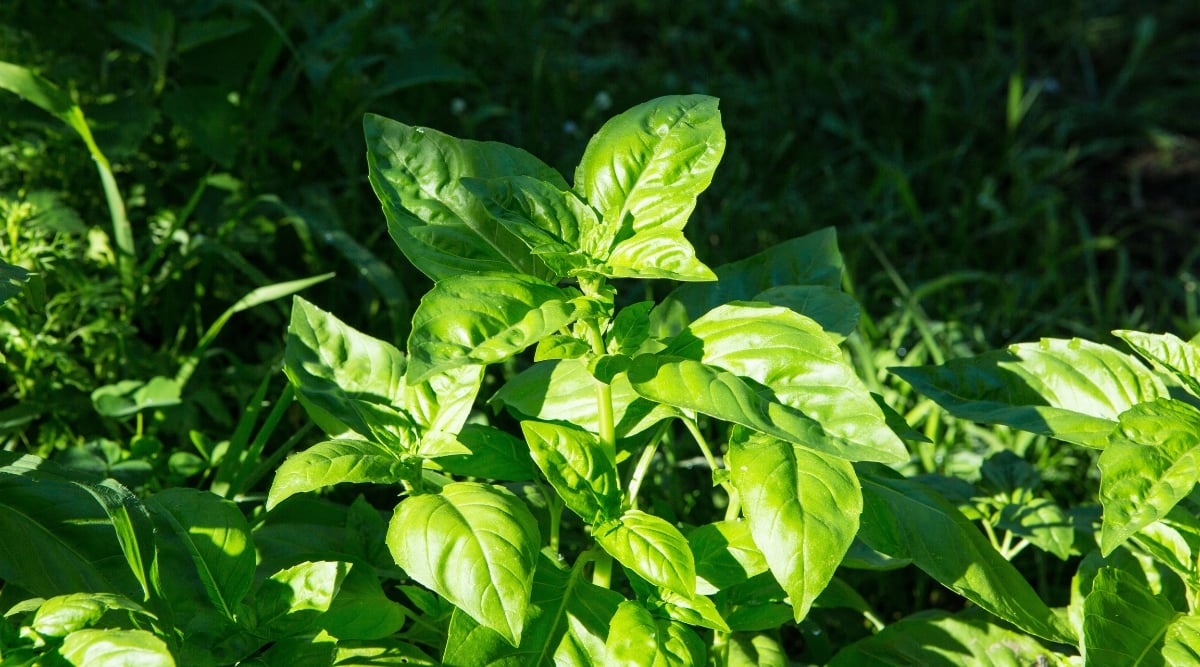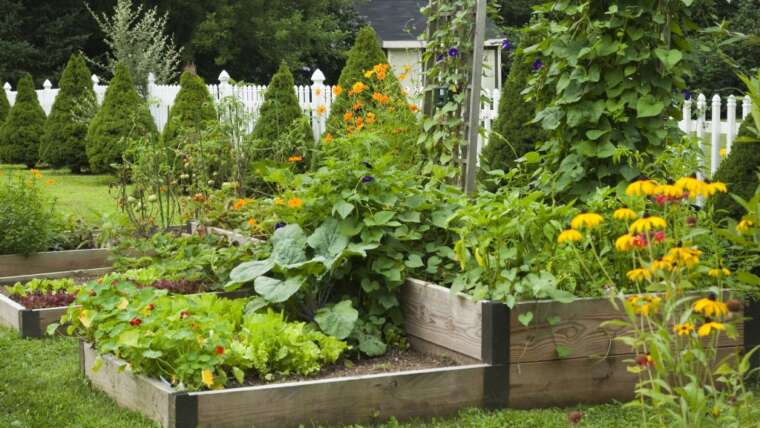If you want to harvest basil all summer, you must know when, where, and how to snip it to promote maximum growth. Picking the first of your herb patch feels like the ultimate summer kick-off. It seemingly takes forever to germinate, grow, and be ready for transplant.
Then, before you know it, your plants need to be pruned several times a week.
But you don’t want to chop off stems haphazardly. You must pick this herb properly to have healthy plants and abundant harvests all season long.
Here I’ll provide some simple how-tos, tips, and tricks we use to maximize our basil yields as professional organic farmers. I also have some awesome preservation options for enjoyment later in the year!
Why it’s Important to Harvest Basil Regularly
Regular harvesting or pruning is essential for all types of basil.
No matter what type of basil you grow in containers or out in your garden, all basil requires and benefits from regular harvesting or pruning. When it comes to basil, the terms “harvest” and “prune” can almost be used interchangeably.
You can use your prunings in pasta, pesto, or fresh green iced tea. Discarding these snippings like you would during the pruning of other vegetables or flowers is unnecessary.
There are four main reasons it is important to harvest this herb regularly:
Encourage Growth
 Pinching back the main stem will prompt your plant to produce side shoots.
Pinching back the main stem will prompt your plant to produce side shoots.
To encourage side shoots and bushy growth, pinch back the main stems about ¼ inch above the first set of true leaves on the main stem shortly after transplanting. You can take a few leaves from the side to enjoy if the plant seems able to withstand the pruning at that time. Pinching back the main stem will encourage your plant to send out side shoots, creating a nice bushy plant and more abundance.
This is the same process when growing snapdragons or zinnias; pinching back the first bloom encourages side shoots. In the flower world, it is also called “deadheading.” Continue with pruning every week or so to keep the growth going.
You’ll notice side shoots growing off the node you cut above soon after pinching back your plant. This is great! You’ve doubled your basil growth just by making one cut, and it will soon be sending out more side shoots after each time you harvest and prune. Continue repeating this method throughout the season by cutting about ¼ inch above a growing node.
Remove Budding Flowers
 This herb’s sensitivity to environmental factors can induce stress, causing it to produce flowers for seeding.
This herb’s sensitivity to environmental factors can induce stress, causing it to produce flowers for seeding.
Basil is very sensitive to environmental factors such as drought, cold temperatures, and heavy rainfall. Any of these events could send the plant into a stressed-out state, causing it to “bolt” or send out flowers to seed.
This will be detrimental to your plants because the flavor will become bitter, and eventually, they will stop producing leaves and instead focus on making flowers. Plus, you’ll end up with basil seeds all over your garden, which you may or may not want.
Get in the habit of walking your garden to note growth, rainfall, etc. Each time you walk past your pesto patch:
- Check the height (if they’re getting “leggy,” pinch the main stems again)
- Check that pests aren’t attacking it
- Ensure there are no flowers in the center, which indicates the plant is stressed and is trying to go to seed
- If you do see a flower, pinch it from the center and continue on your walk
Once flowers begin to bud, your plants will inevitably go to seed. Just keep your eye on those plants, and as long as buds are noticed early and picked off, your plants should be just fine.
Pro tip: Young flowers are edible and tender. Toss them in a salad or brew a delicious homemade basil-infused vinegar using the flowers you pinch off. They have a milder flavor than the adult plant but have lots of great uses.
Harvest Delicious Herbs
 Regularly harvest the leaves and become proficient in pruning to ensure an abundant supply of basil.
Regularly harvest the leaves and become proficient in pruning to ensure an abundant supply of basil.
Basil plants should have 4-6 sets of true leaves and start to bush out before you intentionally harvest leaves for consumption. At this time, you can start harvesting side leaves. To encourage growth at the start of the season, snip off side shoots as you did with the main growing tip.
You want to be sure you are not taking more than the plant can handle at any given time, but basil begs to be harvested once the season has taken off. Who can resist that sweet aroma as you brush past them in the garden?
The more you harvest, the more your plant will provide for you. If you master the basil pruning technique, you will certainly not have a shortage of this delicious herb. Just continue harvesting every week or so so that your plant continues to grow.
Provide Ample Airflow
 Ensure sufficient airflow for your growing plant to prevent fungal diseases and stress.
Ensure sufficient airflow for your growing plant to prevent fungal diseases and stress.
As your plant grows, you want to ensure it has proper airflow to avoid any fungal disease or stress. This is especially important if you have intercropped your basil with another crop, such as tomatoes. More airflow keeps plants happy, and they can breathe freely.
Pro tip: If you are growing in a protected area (like a greenhouse) and have access to power, running a fan will also help prevent disease.
When to Harvest
There are several different harvest windows in the basil lifecycle. You want to use specific techniques depending on the plant’s age and size.
Shortly After Transplant
 After transplanting, you can trim the central growth tip when your basil is well-established.
After transplanting, you can trim the central growth tip when your basil is well-established.
Once your plant becomes established after transplanting, you may snip off the center growth tip, cutting the main stem down to about ¼ inch above the first set of true leaves. Just be sure this will not send your plant into transplant shock; you want to be sure it has had a chance to settle in.
As stated earlier, this will encourage your plant to bush out, sending out many side shoots. If you follow this method all season, snipping off top clusters of leaves at the next set of leaves above a node, the plant will grow outward and become bushier, giving you exponential herbal enjoyment.
Taking Cuttings
 Place cuttings in clean water until they develop roots.
Place cuttings in clean water until they develop roots.
Most varieties take an average of 60-70 days to mature, but if you want to try your hand at succession planting basil and want a head start, try placing the stem tips you pruned off, also known as cuttings, into clean water for a few weeks or until they form roots.
They can then be transplanted into a container or your garden plot, and voila, you have young, cloned basil plants!
Consistently Throughout the Season
 Consistently harvest or prune weekly to redirect its energy toward leaf growth.
Consistently harvest or prune weekly to redirect its energy toward leaf growth.
Even if you don’t need the basil immediately, consistently harvest or prune every week to encourage it to spend its energy growing leaves instead of going to seed. You are communicating to your plant: “You are needed! Please continue providing me with delicious basil!”
If you find yourself with a large harvest but no immediate need, you can share it with a friend, add it to a rustic wildflower bouquet, or preserve it for later.
How to Harvest
 Snipping above a node stimulates lateral growth and leads to a doubled production.
Snipping above a node stimulates lateral growth and leads to a doubled production.
Following the methods discussed above and using sharp, clean snipping shears, snip the stems about ¼ inch above a node about once a week. Snipping above a node encourages bushing out to the sides, allowing the plant to double production.
Optionally, you can snap stems off. However, avoid ripping or tearing the stems because these wounds can become entry points for pathogens.
Final Thoughts
Basil is a summer staple in many gardens across the globe. Regular harvesting and pruning are key to your plants’ long-term success.
If you are new to growing basil, take some time to learn the dos and don’ts, and you’ll be swimming in fresh pesto for tomato sauce, new basil plants, and basil garnishes in no time!




